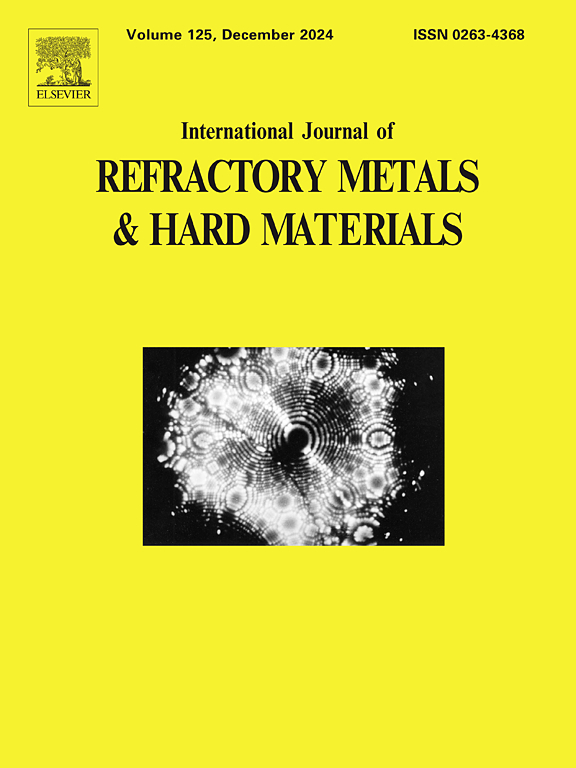Microstructure evolution of WMoNbTiCrAlx (x = 0, 0.25, 0.5, 0.75, 1) multi-principal element alloys
IF 4.2
2区 材料科学
Q2 MATERIALS SCIENCE, MULTIDISCIPLINARY
International Journal of Refractory Metals & Hard Materials
Pub Date : 2025-05-12
DOI:10.1016/j.ijrmhm.2025.107225
引用次数: 0
Abstract
Multi-principal element alloys (MPEAs) based on refractory metals have been studied as potential candidates to replace Ni-based superalloys due to their superior melting temperatures and the promising initial high-temperature properties demonstrated by certain compositions. However, a significant drawback of these refractory metal-based alloys is their high density and low ductility at room temperature. It is known that the addition of Al in MPEAs contributes to reducing density, increasing hardness, and stabilizing the BCC phase. In this study, the influence of Al on the microstructure of five new multi-principal element refractory alloys produced by arc melting, using high-purity raw elements, WMoNbTiCrAlₓ (x = 0, 0.25, 0.5, 0.75, and 1), was analyzed. ThermoCalc software was utilized to support the interpretation of the experimental results. Scanning electron microscopy (SEM) and X-ray diffraction (XRD) were performed on all alloys in both as-cast and heat-treated (1200 °C/24 h) conditions. Additionally, electron backscatter diffraction (EBSD) analyses were performed on the heat-treated alloys. The as-cast alloys exhibited a highly segregated BCC phase with a dendritic structure. After heat treatment, the alloys predominantly presented a BCC phase, with a small volume fraction of the Laves phase being observed. Nanoindentation tests indicated that the addition of Al increases hardness, from 10.5 to 12.2 GPa. Regarding density, there was a decrease with increasing Al content, from 9.7982 to 8.7745 g/cm3.
WMoNbTiCrAlx (x = 0, 0.25, 0.5, 0.75, 1)多主元素合金的组织演变
基于难熔金属的多主元素合金(mpea)由于其优越的熔融温度和某些成分所表现出的良好的初始高温性能而被研究为取代镍基高温合金的潜在候选材料。然而,这些难熔金属基合金的一个显著缺点是它们在室温下的高密度和低延展性。众所周知,在mpea中添加Al有助于降低密度、提高硬度和稳定BCC相。本研究以高纯度原料WMoNbTiCrAlₓ(x = 0, 0.25, 0.5, 0.75, 1)为原料,分析了Al对电弧熔炼五种新型多主元素耐火合金显微组织的影响。利用ThermoCalc软件支持实验结果的解释。在铸态和热处理(1200°C/24 h)条件下对所有合金进行了扫描电镜(SEM)和x射线衍射(XRD)分析。此外,对热处理合金进行了电子背散射衍射(EBSD)分析。铸态合金表现出高度偏析的枝晶BCC相。热处理后,合金以BCC相为主,少量存在Laves相。纳米压痕试验表明,Al的加入使硬度从10.5 GPa提高到12.2 GPa。密度随Al含量的增加而降低,从9.7982 g/cm3降至8.7745 g/cm3。
本文章由计算机程序翻译,如有差异,请以英文原文为准。
求助全文
约1分钟内获得全文
求助全文
来源期刊
CiteScore
7.00
自引率
13.90%
发文量
236
审稿时长
35 days
期刊介绍:
The International Journal of Refractory Metals and Hard Materials (IJRMHM) publishes original research articles concerned with all aspects of refractory metals and hard materials. Refractory metals are defined as metals with melting points higher than 1800 °C. These are tungsten, molybdenum, chromium, tantalum, niobium, hafnium, and rhenium, as well as many compounds and alloys based thereupon. Hard materials that are included in the scope of this journal are defined as materials with hardness values higher than 1000 kg/mm2, primarily intended for applications as manufacturing tools or wear resistant components in mechanical systems. Thus they encompass carbides, nitrides and borides of metals, and related compounds. A special focus of this journal is put on the family of hardmetals, which is also known as cemented tungsten carbide, and cermets which are based on titanium carbide and carbonitrides with or without a metal binder. Ceramics and superhard materials including diamond and cubic boron nitride may also be accepted provided the subject material is presented as hard materials as defined above.

 求助内容:
求助内容: 应助结果提醒方式:
应助结果提醒方式:


